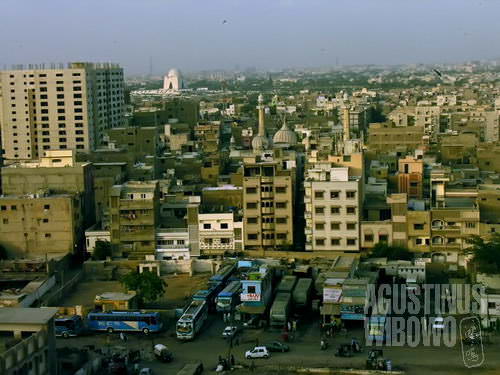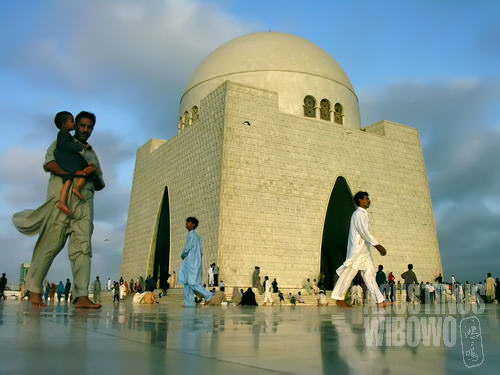Karachi – The Biggest City of Pakistan
May 30, 2006

Karachi
Talking about the biggest city of Pakistan, no, it’s not the new capital of Islamabad, it’s the port city of Karachi. Karachi was the capital of the new republic after the partition, but after the capital shift to the north, Karachi still serves as the economic center of the country.
Karachi house the mausoleum of the founder of Pakistan, Mr. Muhammad Ali Jinnah, known as Quaid-i-Azam (the prime leader). This mausoleum is located not far from city center, and becomes the main pilgrimage spots for Pakistanis from the whole country. The architecture itself cannot be described more than distinctive, but still interesting place to spot the pilgrims. Karachi also has beaches. Cliffton beach might be the most popular in the city. If there is something that this beach doesnt share with other beaches in the world, it is the camels provided for the tourists to linger around the sand. It is not common for the visitors to swim here, so dont expect spotting girls with bikinis like those in Bali. In weekends, the beach might be crowded, by single visitors, couples, families, and even gay couples, who share affections quite openly on the benches near the main road.

Slum in Karachi
Karachi is a city of irony and dillema. In Karachi you may see the most number of high rise buildings. The city center in Saddar is always busy with the bazaars, selling from birds, chickens, until DVD players. The buildings are tall, but not quite preserved. The area is dotted by old imperial buildings like churches, clock towers, and even parsee church. There are many unfinished high rise constructions due to mismanagement, or even when they finished, they decided not to use the buildings due to various reason, e.g. the buildings is leaning to a certain degree imitating the Pisa tower in Italy. the mismanagement shown also in a hospital near the Jinnah road where the farst half of its 12 floors were completely unuseable due to bad quality of material.

Contrast
The apartments have beautiful names, inviting, like City View or Glamour View, but the name doesnt reflect the quality of the buildings. Rats running everywhere, water problem everyday, and dusty poluted area. Life here is not easy. The lift is always broken. There were two lifts, but they never allow the two to work together. There should be one under rotten condition, broken, and awaiting the turn of the other one to be broken, then it will be repaired. Life is also more difficult with the bureaucracy. Paying bills, which is a five minute work in other countries, might be hours here in Pakistan, as the officers would like to chat with you about the newest cricket matches etc.
In Karachi there are two muttahidas, Muttahida Majlis i Alam and Muttahida Qaumi Movement, with myriads of supporter organizations, and each of them waiting for its queue to call for strike. The last strike was on 26 May, following the bombing in Karachi during the Maulid celebration which killed some leaders of Sunni Tehrik organization. This was not the first strike. Earlier on 16th there were also call for strike for the whole Sindh, and it was quite successful. I was in Umerkot that time and in this Hindu populated area, the strike was a vain. Not talking whether their point was wrong or not, the life of the people in the city was heavily affected. News in Dawn saying that the leaders were satisfied by the result of the strike which was peacefully observed. There were no public transports so officers couldnt go to their office and students failed to join the exam (which made the schools to reschedule the exams). The most suffered probably is the people who have to struggle for life on street, like fruit sellers as they dont have any business during the strike day, and i am sure the leaders of those muttahidas wont have to much time to give them the food of the day. People are protesting, of course. On Dawn you can read many protests, like “our country is so backward, education is left behind, and now students have more holidays because of the strikes”.

Mausoleum of the Founding Father of Pakistan
But Karachi is not only full of problems. There are many enjoyable places, like the Farsi settlement, with its initially low fences but then risen up due to the security of the city. At Cliffton there is settlement of upper class society, including Bhutto family, and the architecture of the houses resemble little palaces. There is Indus River School of Art there, which is the biggest art school in Karachi, built with Parsee architecture. The interesting thing is that the building is actually moved from the city centre, brick by brick, by the teachers of the school.
Karachi also offered huge variety of food, from biryani until Chinese dishes. And seafood of the city is also worth to note.

Leave a comment